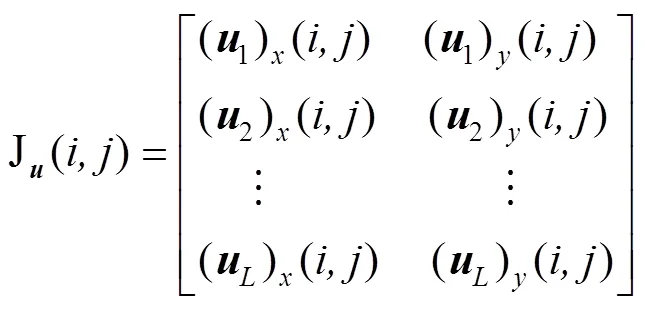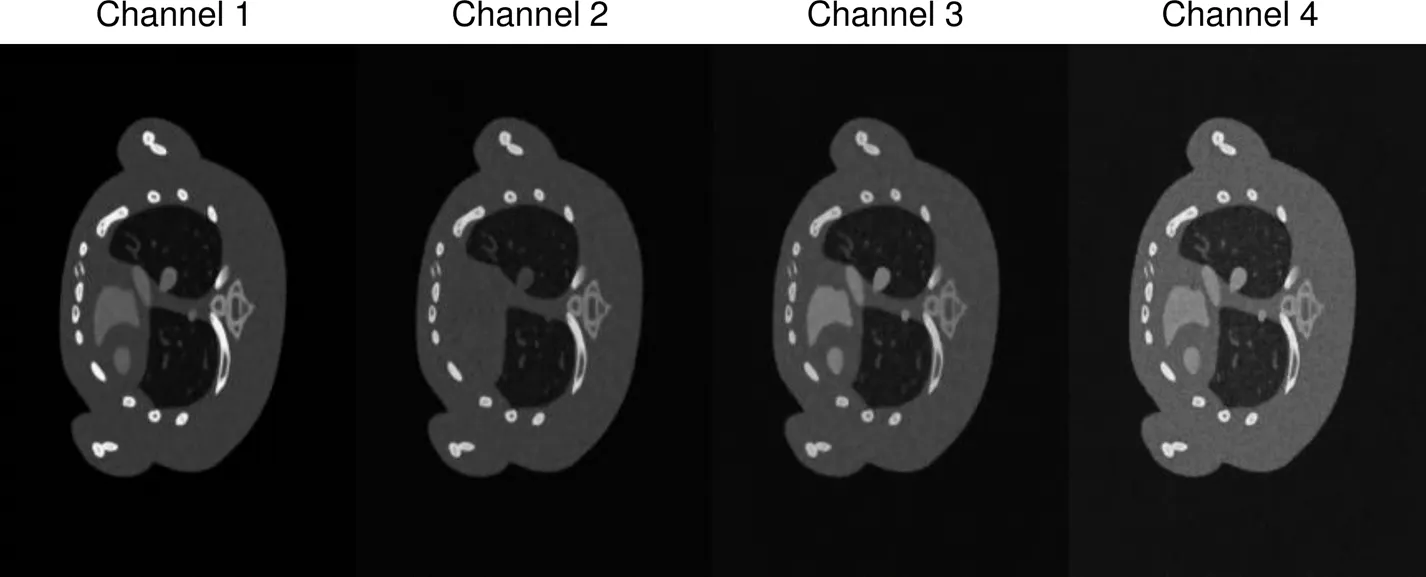多通道联合的广义总变分能谱CT重建
2021-10-18连祥媛孔慧华潘晋孝高文波
连祥媛,孔慧华,潘晋孝*,高文波,王 攀
多通道联合的广义总变分能谱CT重建
连祥媛1,2,孔慧华1,2,潘晋孝1,2*,高文波1,2,王 攀3
1中北大学理学院,山西 太原 030051;2信息探测与处理山西省重点实验室,山西 太原 030051;3湖南云箭集团有限公司,湖南 辰溪 419503
基于光子计数探测器的能谱CT在材料分解、组织表征、病变检测等应用中具有巨大的潜力。在重建过程中,通道数的增加会造成单通道中光子数减少,从而导致重建图像质量下降,难以满足实际需求。本文从能谱CT重建的角度出发,将广义总变分向矢量延伸,利用奇异值的稀疏性,促进图像梯度的线性依赖,提出一种基于核范数的多通道联合广义总变分的能谱CT重建算法。在图像重建过程中,多层共享结构信息,同时保留独特的差异。实验结果表明,本文提出的算法在抑制噪声的同时,能够更有效地恢复图像细节及边缘信息。
CT重建;能谱CT;广义总变分;核范数;多通道联合

1 引 言
在基于光子计数探测器(photon-counting detector,PCD)的能谱CT[1]中,PCD技术消除了电子噪声,提供了比传统CT探测器更高的信噪比[2]。然而,PCD技术仍然存在两个主要的问题,首先,单个能量通道只包含总光子的一小部分;其次,大部分PCD只能承受有限的计数率,所以从PCD获得的多通道投影通常包含非常强的泊松噪声。因此,开发能谱CT重建算法对于改善临床应用具有重要意义[3]。
压缩感知理论的出现,使正则化约束项的迭代类重建算法发挥出巨大的潜力。能谱CT重建中,正则化约束项以先验图像引导和稀疏性条件为主。先验图像引导以Yu采用全光谱图像作为先验图像的压缩感知(prior image constrained compressed sensing,PICCS)算法[4]为代表,稀疏性条件[5-8]包括全变分、紧框架、小波和字典学习等已被应用于CT重建,并取得了不同程度的成功。受空间域信息相关性的启发,Zhang等[9]将总变分与能谱均值相结合,提高重建图像的质量。Li等[10]提出一种能谱非局部均值的方法,利用图像相关性来抑制噪声和条纹伪影。Hu等[11]利用张量字典块的稀疏性表示来提高重建质量。陈佩君等[12]提出一种总变分与传统张量字典学习结合的重建算法,可进一步恢复图像的微小结构,有效抑制噪声。为了更好地利用能谱CT在能量轴方向的信息相关性,Rigie等[13]将总变分向矢量延伸,提出了总核变分(total nuclear variation,TNV)正则化方法,可以更好地保存图像特征。Niu等[14]提出了一种alpha发散约束的广义总变分(total generalized variation,TGV)方法用于稀疏视角X射线CT图像重建,有效地消除总变分正则化中经常出现的阶梯状和斑片状伪影。
为了更好地使用空间的结构信息,本文将单通道的TGV向矢量延伸,提出一种基于核函数的多通道联合TGV的能谱重建算法,简称Mutli-NTGV。利用核范数作为约束,增强通道间耦合,恢复图像的结构特征。
2 理论推导
2.1 单通道TGV正则化



2.2 基于核范数的多通道TGV正则化

当两幅图像拥有相同的曲线时,两幅图像具有相同方向的梯度,反之亦然[16]。如果各通道图像的所有梯度向量是平行的或反平行的,那么雅可比矩阵的秩将是1,因此只有一个非零奇异值。在此基础上,若各通道间图像梯度平行,会使得核范数最小,将TGV推向矢量场形式如下:


类似地:

其中:

矢量场的离散梯度算子为

对称化梯度算子为


若:

则:
3 算法模型
3.1 基于核范数的多通道联合TGV能谱CT重建算法
在能谱CT的不同能量通道下,图像的梯度信息是相似的。为了更好地克服基于导数的正则化方法的缺陷,有效地利用通道间的结构化信息。提出一种基于核范数的多通道联合TGV能谱CT重建算法,其目标函数可以表述为以下凸极小化问题:

3.2 模型求解



式(6)中含有两个变量,可以采用交替迭代的方法优化,将上述式子分裂成两个子问题:





重新整理正则项的形式,将式(9)的最小化问题表述为


采用一阶原始—对偶算法解决上述鞍点问题。
具体的迭代步骤为
在此过程中,青少年价值观与道德判断将会得到进一步提升,出现攻击行为的可能性也会大大降低。与此同时,群体观与自我人际价值感之间的关系主要呈现负相关关系。主要是指越是认为自我观重要的个体,个体存在的人际价值感愈加淡薄,相反则反之。可以说,学校方面必须加强对青少年价值观与道德判断方面的教育能力,尽量规避青少年攻击行为的出现。为了进一步提升青少年价值观与道德判断能力,教师可以适当提升关于这方面的教育能力,确保青少年规范自身行为。




其中:离散梯度算子的逆算子为

对称化算子的逆算子为



能谱的Mutil-NTGV算法步骤:
4 实验结果
4.1 实验设置
为验证本文算法的有效性,采用滤波反投影重建算法(FBP)、联合代数重建算法(SART)、总变分正则项的迭代重建算法(TV)、基于张量的字典学习算法(TDL)、广义总变分正则化的迭代重建算法(TGV)为比较算法。所用算法都是用MATLAB和C++的混合模式实现的,接口在MATLAB中实现,所有的大规模计算部分在C++中实现,并通过MEX函数进行编译。本文采用峰值信噪比(PSNR)、归一化均方根误差(NRMSE)与结构相似度指数(SSIM)定量评价各方法性能,验证算法的有效性。
4.2 小鼠胸腔仿真实验

图1为FBP、SART、TV、TDL、TGV与Multi-NTGV算法迭代30次的重建效果图。
从图1可以看出,FBP、SART重建的结果中噪声很强,TDL、TGV与Mutli-NTGV都可以不同程度地减少各个能谱通道下噪声的影响。在重建效果的对比中,可以明显地看出TV在平滑噪声的过程中,容易产生阶梯状伪影,导致重建效果不佳。TDL平滑效果较好,但无法区别噪声与细节,局部去噪效果不佳。TGV很好地克服了TV中所产生的阶梯伪影的状况,保存更多的细节,但在边缘部分会产生一点弱化的效果。本文提出的方法利用了通道间的结构化信息,不仅有效地抑制了噪声,而且对于微小的结构也保持得很好,边缘更加清晰。
五种算法重建过程中的NRMSE、PSNR与SSIM指标如图2所示,FBP重建效果的评价指标如表1所示。由图2可以看出,在前三个通道中,本文所提出的算法明显优于其他算法,在第四通道中,虽然Mutli-NTGV算法与TDL、TGV的数量性评价结果相近,但是从重建图效果可以看出Mutli-NTGV方法优于其他方法。实验结果表明,本文所提的方法在各个通道中,会保持较大的优势,极大地提升了重建图像的质量。
4.3 临床小鼠实验
为了进一步验证所提出方法的有效性,采用了MARS(Medipix All Resolution System)微型CT上采集的来自真实临床前小鼠的投影。电压设置为120 kV,电流为175 mA。从照射源到系统原点的距离为158 mm,到探测器的距离为255 mm。在整个扫描范围内均匀收集了13个能量通道的371个投影视图。探测器一行1024个元素,单位长度为55mm。
图3为各算法对临床前小鼠的重建效果图,从上到下依次展示的是第1、3、5和7通道的效果图。实际小鼠切片实验中,各算法重建结果与小鼠胸腔仿真实验类似,FBP与SART重建效果中含有大量的噪声,其余方法都在一定程度上达到了去噪的效果,从实验结果可以明显看出,在各个重建算法中,Mutli-NTGV在临床小鼠的重建效果较好。

图1 小鼠模型的重建结果。从左到右的方法依次为FBP、SART、TV、TDL、TGV与Mutli-NTGV,从上到下依次为1到4通道

图2 小鼠模型重建效果的数量性评价指标。 从左到右行依次为NRMSE、PSNR、SSIM,从(a)到(d)行依次为1到4通道

表1 FBP重建的数量性评价指标

图3 临床小鼠模型的重建结果。从左到右的方法依次为FBP、SART、TV、TDL、TGV与Mutli-NTGV,从上到下依次为1, 3, 5, 7通道
5 结 论
本文针对能谱CT,提出了一种基于核范数的多通道联合广义总变分能谱CT重建算法,将TGV推向矢量化,采用逐像素的更新方式,使用多通道联合的二阶广义总变分作为专用的正则化函数在图像重建步骤中耦合多个通道,耦合分别在一阶和二阶导数的水平上用核范数和F范数约束来实现,促进了多个图像通道的梯度的线性依赖,从而使边缘对齐。该方法在噪声条件下,可以保持更多的细节与更清晰的边缘。仿真数据与实际数据的运行结果表明,本文提出的算法具有较好的鲁棒性。但是,本文算法中参数较多,采用经验选取,比较耗费时间,后续研究中可以研究采用更灵活的参数选取模型。
[1] Niu S Z, Bian Z Y, Zeng D,. Total image constrained diffusion tensor for spectral computed tomography reconstruction[J]., 2019, 68: 487–508.
[2] Taguchi K, Iwanczyk J S. Vision 20/20: Single photon counting X-ray detectors in medical imaging[J]., 2013, 40(10): 100901.
[3] Dong X, Niu T Y, Zhu L. Combined iterative reconstruction and image-domain decomposition for dual energy CT using total-variation regularization[J]., 2014, 41(5): 051909.
[4] Yu Z C, Leng S, Li Z B,. Spectral prior image constrained compressed sensing (spectral PICCS) for photon-counting computed tomography[J]., 2016, 61(18): 6707–6732.
[5] Zhang W K, Zhang H M, Wang L Y,. Limited angle CT reconstruction by simultaneous spatial and Radon domain regularization based on TV and data-driven tight frame[J]., 2018, 880: 107–117.
[6] Luo X Q, Yu W, Wang C X. An image reconstruction method based on total variation and wavelet tight frame for limited-angle CT[J]., 2018, 6: 1461–1470.
[7] Us D, Ruotsalainen U, Pursiainen S. Combining dual-tree complex wavelets and multiresolution in iterative CT reconstruction with application to metal artifact reduction[J]., 2019, 18: 116.
[8] Miao J Y, Cao H L, Jin X B,. Joint sparse regularization for dictionary learning[J]., 2019, 11(5): 697–710.
[9] Zhang Y, Xi Y, Yang Q S,. Spectral CT reconstruction with image sparsity and spectral mean[J]., 2016, 2(4): 510–523.
[10] Li B, Shen C Y, Chi Y J,. Multienergy cone-beam computed tomography reconstruction with a spatial spectral nonlocal means algorithm[J]., 2018, 11(2): 1205–1229.
[11] Hu D L, Wu W W, Xu M R,. SISTER: spectral-image similarity-based tensor with enhanced-sparsity reconstruction for sparse-view multi-energy CT[J]., 2020, 6: 477–490.
[12] Chen P J, Feng P, Wu W W,. Material discrimination by multi-spectral CT based on image total variation and tensor dictionary[J]., 2018, 38(11): 1111002.
陈佩君, 冯鹏, 伍伟文, 等. 基于图像总变分和张量字典的多能谱CT材料识别研究[J]. 光学学报, 2018, 38(11): 1111002.
[13] Rigie D S, Patrick J L R. Joint reconstruction of multi-channel, spectral CT data via constrained total nuclear variation minimization[J]., 2015, 60(5): 1741–1762.
[14] Niu S Z, Huang J, Bian Z Y,. Iterative reconstruction for sparse-view X-ray CT using alpha-divergence constrained total generalized variation minimization[J]., 2017, 25(4): 673–688.
[15] Kristian B, Karl K, Thomas P. Total Generalized Variation[J]., 2010, 3(3): 492–526.
[16] Ehrhardt M J, Arridge S R. Vector-valued image processing by parallel level sets[J]., 2014, 23(1): 9–18.
[17] Sidky E Y, Jørgensen J H, Pan X C. Convex optimization problem prototyping for image reconstruction in computed tomography with the Chambolle–Pock algorithm[J]., 2012, 57(10): 3065–3091.
Joint multi-channel total generalized variational algorithm for spectral CT reconstruction
Lian Xiangyuan1,2, Kong Huihua1,2,Pan Jinxiao1,2*, Gao Wenbo1,2, Wang Pan3
1School of Science, North University of China, Taiyuan, Shanxi 030051, China;2Shanxi Key Laboratory of Signal Capturing & Processing, North University of China, Taiyuan, Shanxi 030051, China;3Hunan Vsngusrd Group. Co. Ltd, Chenxi, Hunan 419503, China

The reconstruction results of the mouse model by Mutli-NTGV
Overview:Spectral computed tomography (CT) based on photon-counting detectors, has great potential in material decomposition, tissue characterization, lesion detection, and other applications. During the reconstruction, the increase of the number of channels will reduce the photon number in a single channel, resulting in the decline of the quality of the reconstructed image, which is difficult to meet the actual needs. To improve the quality of image reconstruction, this paper proposes a joint multi-channel total generalized variational based on the unclear norm for spectral CT reconstruction. Firstly, in the reconstruction for spectral CT, the image structure of each channel is highly similar, and the reconstruction of a single channel will ignore the structural information of each channel. Second, gradient information contains a lot of structured information and features of the image. When two images have the same curve, the two images have the same direction gradient and the converse is also true. In order to better utilize the image’s structural information between channels, the new regularization function is applied to spectral CT reconstruction. The research shows that if the edges of the two images are aligned, the two images have the same gradient. The image gradients between channels are parallel, which will minimize the nuclear norm. The algorithm will extend total generalized variation to the vector, with the aim of overcoming defects of existing derivative-based regularization. The paper proposed a joint multi-channel total generalized variational for spectral CT reconstruction, employing a vectorial second-order total generalized variation function as joint regularization. The method adopts pixel-by-pixel updating in the image reconstruction, and the multi-channel image coupling is realized by kernel norm and F-norm constraints at the level of first and second derivatives. The nuclear norm and frobenius norm coupling promote joint sparsity of the edge sets and dependence of the gradients. Joint multi-channel total generalized variational is used to promote the linear dependence of the multi-channel image’s gradient so that the image edges of each channel are aligned. The structural information of the multi-channel image is shared during the image reconstruction process while unique differences are preserved. The experiment was done on a numerical mouse thorax phantom and clinical mouse data. The quantitative results of peak signal to noise ratio (PSNR), normalized root mean square error (NRMSE) and structure similarity index (SSIM) show that the proposed algorithm greatly improves the image quality. Experimental results show that the proposed algorithm can effectively recover image details and marginal information while suppressing noise.
Lian X Y, Kong H H,Pan J X,Joint multi-channel total generalized variational algorithm for spectral CT reconstruction[J]., 2021, 48(9): 210211; DOI:10.12086/oee.2021.210211
Joint multi-channel total generalized variational algorithm for spectral CT reconstruction
Lian Xiangyuan1,2, Kong Huihua1,2,Pan Jinxiao1,2*, Gao Wenbo1,2, Wang Pan3
1School of Science, North University of China, Taiyuan, Shanxi 030051, China;2Shanxi Key Laboratory of Signal Capturing & Processing, North University of China, Taiyuan, Shanxi 030051, China;3Hunan Vsngusrd Group. Co. Ltd, Chenxi, Hunan 419503, China
Spectral computed tomography (CT) based on photon-counting detectors, has great potential in material decomposition, tissue characterization, lesion detection, and other applications. During the reconstruction, the increase of the number of channels will reduce the photon number in a single channel, resulting in the decline of the quality of the reconstructed image, which is difficult to meet the actual needs. To improve the quality of image reconstruction, joint multi-channel total generalized variational based on the unclear norm for spectral CT reconstruction was proposed in this paper. The algorithm will extend total generalized variation to the vector, and the sparsity of singular values is used to promote the linear dependence of the image gradient. The structural information of the multi-channel image is shared during the image reconstruction process while unique differences are preserved. Experimental results show that the proposed algorithm can effectively recover image details and marginal information while suppressing noise.
CT reconstruction; spectral CT; total generalized variation; nuclear norm; joint multi-channel
连祥媛,孔慧华,潘晋孝,等. 多通道联合的广义总变分能谱CT重建[J]. 光电工程,2021,48(9): 210211
Lian X Y, Kong H H,Pan J X,Joint multi-channel total generalized variational algorithm for spectral CT reconstruction[J]., 2021, 48(9): 210211
10.12086/oee.2021.210211
TP391
A
2021-06-23;
2021-08-26
国家自然科学基金资助项目(61801437,61871351,61971381)
连祥媛(1994-),女,硕士研究生,主要从事图像重建与图像处理方面的研究。E-mail:1393550566@qq.com
潘晋孝(1966-),男,博士,教授,主要从事信息处理与图像重建方面的研究。E-mail:panjx@nuc.edu.cn
National Natural Science Foundation of China (61801437, 61871351, 61971381)
* E-mail: panjx@nuc.edu.cn
